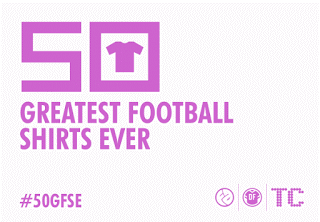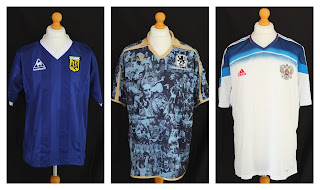It's been far too long since we welcomed our old friend Ed Carter into the Football Attic fray, but we're delighted to say he's back once again, this time with some fine observations on the traditions of shirt numbering...
I am not mad.
On my computer I have a list of every England football squad ever submitted for a major international finals tournament. Remember, please, that I am not mad when I tell you that if every squad was like the one we sent to the 1950 World Cup - where no teams had fixed squad numbers - I would not have bothered to curate this list in the first place. I love the numbers of sport. I love the statistics, I love the scores but above all I love the numbers that are assigned to competitors to differentiate them.
I once discussed this with someone and they immediately started talking to me about the Olympic Games. I am sure that, if I understood the innumerable arcane points of interest in the way Olympic competitors are numbered I would be completely enraptured. But for me, Olympic numbers can be summed up by the way they are affixed to the competitor they demarcate: throwaway, paper-thin, ephemeral. They don't capture my interest at all.
What interests me is the sports where competitors are given a number and they wear it over the course of an entire season or beyond. Two years ago, my beloved Formula 1 motor racing decided to introduce career car numbers to the drivers, as is the case in motorcycle racing and in American motor sports. Once a competitor is issued a number of their choosing they will carry it throughout their entire tenure in the sport, regardless of team or achievement. As an identifier, and I suppose as a marketing tool, it was a diamond-tipped bullet of pure genius. I tried to maintain my decorum throughout. But I failed and immediately made a list.
I am not mad.
Football. The old association football. When I was little, football players wore shirts numbered from 1 to 11, apart from for during international tournaments, where numbers as lofty as 20, 21 or 22 could make a thrilling appearance. The dark hearts behind the Premier League had other ideas, and from 1993/94 squad numbering has slowly percolated its way down throughout the football pyramid.
I'm nothing if not a staunch traditionalist (in addition to not being mad, which it is important to remember) and as such I should be appalled by this. To be fair, I occasionally am. But on the whole, I completely love it. It is probably my favourite thing about football, now I think about it. If they stopped wearing numbers again, as they used to in the old old days, I'd probably go and find something else to watch. Greyhound racing, perhaps. Or a tortoise with a number painted on its shell in Tip-pex.
Originally, the number a football player wore - as is the commonality of any sport where the numbering of its participants still grabs me - was specific to their position and role on the field. Number 1 was always the goalkeeper; 2 and 3 were the full backs; 4, 5 and 6 were, from right to left, the half backs and numbers 7 to 11 were the forwards: again, from right to left, the outside, inside, centre, inside and outside. The initial challenge to squad numbering, you might think, is how do you maintain this positional system when there is every number from 1 to 99 to choose from? In reality of course, people had been taking liberties within the 1-11 framework for years.
For a start, there were national differences. When 4-4-2 replaced 2-3-5 as the standard formation in soccer, all hell broke loose. The English approach was to pull the numbers of the old centre and left halves back into defence as the centre backs so that a team might line up GK 1; FB 2, FB 3, CB 5, CB 6; RM 7, CM 8, CM 4, LM 11; CF 9, CF 10. In Germany, the corresponding numbers might be 1; 2, 3, 4, 5; 7, 10, 6, 8; 9, 11. In Brazil and Argentina, the centre backs assumed the numbers of their predecessors, the full backs - 2 and 3. 4 and 6, the right and left halves, became the gallivanting, marauding right and left full (wing) backs. The defensive midfielder wore 5, the central midfielder 8 and then the four attack-minded players were numbered as they were in Britain.
Or weren't. Kevin Keegan wore 7 for Liverpool but was the centre forward. Bobby Charlton was number 9 but he was an attacking midfielder. Pele, the world's greatest ever number 9, wore 10 because a Brazilian FA official assigned him that number at random upon the team's arrival in Sweden for the 1958 World Cup. Perhaps the most exciting thing of all was that Johan Cruyff wore 14 for Ajax, Barcelona and the Netherlands, a rare example of a player who was so good that officialdom is willing to waive the rules on their behalf.
Liverpool Football Club were the forerunners of pretty much everything in English football when I - or pretty much anyone over the age of 30 and under the age of 60 - was growing up. But as well as their excellence on the pitch, their approach to squad selection and development allowed them to be progenitors of the squad numbering system in English football. A player would break into the team and, if they showed sufficient quality to stay there, would very often retain the number. The aforementioned Keegan wore 7 because he made his first foray into the starting XI as a right winger. When I grew up watching the last great Liverpool side of the late 1980s, Ronnie Whelan wore 5 in central midfield because that was the number he had inherited from Ray Kennedy, who had himself worn it as a left-sided midfielder. Steve McMahon wore 11. John Aldridge, one of British football's greatest ever centre forwards, number 8. Steve Nicol frequently turned out at right back in a very Brazilian number 4. Gary Gillespie often partnered Alan Hansen (6) at centre back wearing 3. None of these numbers were strictly right, but they all meant something. That is what is so important. It demarcates the players and the positions on any given day, but also the progression of time and season. A sense of history and purpose and of being part of something more significant than just your part in it.
"I tell you what you must love then. You must love the way the Netherlands turned out numbered in alphabetical order for the 1974 World Cup." Well, no, actually I hate it. Because there's no meaning behind any of it. No thought, no history, no romance, nothing. What is even worse than Jan Jongbloed lining up in goal wearing number 8 is that had the system been properly implemented, he would have been number 9: as befitted his talismanic status, Johan Cruyff was granted the number 14 which should, by right, have belonged to Johan Neeskens. Cruyff's alphabetical assignation should have been number 1. It is things like that which make me glad Holland did not win the 1974 World Cup.
Had Cruyff worn 1, though, I suppose alphabetical squad listing is something I could get behind a little more; although it seems a staggeringly heartless and utilitarian thing to do, the sort of thing that might have happened in a book about World Cup football written by George Orwell.
The great alphabetisers of world football, though, were Argentina. In 1978 they did it properly, with no exceptions made. Number 1 was River Plate's midfielder Norberto Alonso. Ossie Ardiles wore 2. Mario Kempes, the goalscoring hero of the final, managed to get number 10. They remain the only team to be numbered alphabetically to win the World Cup. As such, they continued the practice in both 1982 and 1986, although on both occasions the system was modified to allow Diego Maradona to wear 10. In 1986, Jorge Valdano was also pandered to, wearing number 11.
Even staid old England got crazy enough to pull an alphabetic shenanigan on us. Perhaps it was the aching twelve year chasm of spiralling failure and national shame, but when the team arrived in Spain for the 1982 World Cup they were numbered according to the single most convoluted system ever seen at a football tournament, until such a time as any country wants to turn up graded by colour of hair.
Of the 22 man squad, 18 were given a number according to their name. Trevor Brooking, an archetypal number 10, wore 3. Steve Coppell, a number 7 all day long got number 5. But a goalkeeper wearing a number between 2 and 11 was too much for the FA to contemplate, so the custodians were corralled into their own individual alphabetic section and then duly handed a number 1, 13 or 22 shirt. The other exception was Kevin Keegan, England's exception-ally unfit talisman, who briefly wore his traditional number 7 shirt during a substitute appearance against the hosts in the final match of an injury-stricken campaign. The whole never-repeated experiment is, by quite some margin, the most louche thing the English football team have ever done. Including the fact that Fabio Capello used to give the substitute goalkeeper number 12, the very thought of which makes me feel a bit peculiar. Good peculiar? Bad peculiar? I don't even know.
Nowadays, squad numbering has settled down a little bit. The worst excesses, in this country at least, seem to be out of the way. The majority of players still seemingly gravitate to wearing a shirt numbered between 1 and 11 to signify their quality and irreplaceability. Additionally, there have become new paradigms set for the outlying numbers. See someone wearing number 21 or 27 or 33 and you pretty much know the sort of player you're going to get.
The great hero of English squad numbering is undoubtedly Sir Alex Ferguson, who maintained a squad kept zealously within an outer limit of numbers in the low 30s, as well as making superstars of Roy Keane's 16 and Paul Scholes' 18. That's precisely the point of squad numbering done well: both Michael Carrick and Ashley Young spoke out in the press upon their arrival at Old Trafford about the honour of being bestowed with these grand old numbers and the expectation that comes with them.
The villain of the piece? Arsene Wenger. Purely and simply for the most heinous shirt numbering crime ever committed in the British game, granting William Gallas the number 10 in 2006. The nine intervening years have done nothing to calm my volcanic revulsion to such an act. I neither support Arsenal nor do I have any strong feelings either way to Gallas. But when a player - a centre half - walks in to your club and asks to wear the number 10 shirt only just vacated by Dennis Bergkamp, a trip to the Job Centre is clearly the only eloquent response. Instead, Wenger granted the request. I've not forgotten and it can never be forgiven. But as long as there are squad numbers, there'll always be these moments. I've come, broadly speaking, to accept it. European games, with their attendant players pratting across the screen wearing number 63 or 87, can now pass with me barely even needing to clench my buttocks or grind my teeth. Or vice versa. There was many a clenched tooth and ground buttock round my house in the early noughties.
Although I still hear Barry Davies' disapproving voice ("what a RIDICULOUS number to see on an association football field") whenever anyone is tootling around in a 38, I have started to see the brilliance of it rather than being hung up on the incongruity. The best of the current crop is Yaya Toure's 42 shirt. You need to be good to wear a 42 shirt through choice. There's nowhere to hide in a number 42 shirt. One day soon, probably in no more than ten years, you'll hear some pundit somewhere saying that Manchester City have never properly replaced their 42 shirt. It's a brave new world, but scratch the surface and it's a comfortingly familiar one.
Our grateful thanks to Ed Carter for his latest guest post on The Football Attic, and a reminder to you all that you can hear him every week with Ian King on the 200% Podcast and see his sublime illustrations and paintings over at his Redbubble website. As with all good journeys, so too must the 50 Greatest Football Shirts Ever come to an end... and so we hereby present the Top 5!
As with all good journeys, so too must the 50 Greatest Football Shirts Ever come to an end... and so we hereby present the Top 5!


























